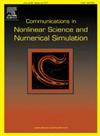一阶欧拉法是计算Kuramoto振子联想记忆网络的有效方法
IF 3.8
2区 数学
Q1 MATHEMATICS, APPLIED
Communications in Nonlinear Science and Numerical Simulation
Pub Date : 2025-02-06
DOI:10.1016/j.cnsns.2025.108650
引用次数: 0
摘要
研究了联想记忆网络的kuramoto型模型及其在二值模式检索和分类中的应用。在该模型中,耦合函数由一个Hebbian项和一个非负参数的二阶傅立叶项组成。文献中已经建立了对应于二元模式的平衡态的稳定/不稳定理论。本文对该模型的计算方法进行了研究。在实际情况下,快速响应是非常需要的。然而,随着网络规模的扩大,高维会带来沉重的计算成本,甚至是维数的诅咒。给出了一阶欧拉法给出的离散时间表达式,并证明了该方法在连续时间模型的计算中是有效的。与传统的高阶龙格-库塔方法相比,该方法简化了计算,并通过仿真验证了计算量的降低。本文章由计算机程序翻译,如有差异,请以英文原文为准。
First-order Euler method is effective for computation of associative-memory network of Kuramoto oscillators
We consider the Kuramoto-type models for associative-memory networks and its applications in binary pattern retrieval and classification. In this model, the coupling function consists of a Hebbian term and a second-order Fourier term with nonnegative parameter. The theory of the stability/instability has been established in literature for the equilibria corresponding to binary patterns. In this short communication, we investigate the computation method of this model. In practical situations, quick-response is highly desired. However, as the size of the network increases, the high dimension causes heavy computation cost, and even a curse of dimensionality. We provide the discrete-time formulation given by the first-order Euler method, and show that this method is effective in the computation of the continuous-time model. This simplifies the computation and simulations verify that the computation cost is reduced, comparing to the conventional higher-order Runge–Kutta method.
求助全文
通过发布文献求助,成功后即可免费获取论文全文。
去求助
来源期刊

Communications in Nonlinear Science and Numerical Simulation
MATHEMATICS, APPLIED-MATHEMATICS, INTERDISCIPLINARY APPLICATIONS
CiteScore
6.80
自引率
7.70%
发文量
378
审稿时长
78 days
期刊介绍:
The journal publishes original research findings on experimental observation, mathematical modeling, theoretical analysis and numerical simulation, for more accurate description, better prediction or novel application, of nonlinear phenomena in science and engineering. It offers a venue for researchers to make rapid exchange of ideas and techniques in nonlinear science and complexity.
The submission of manuscripts with cross-disciplinary approaches in nonlinear science and complexity is particularly encouraged.
Topics of interest:
Nonlinear differential or delay equations, Lie group analysis and asymptotic methods, Discontinuous systems, Fractals, Fractional calculus and dynamics, Nonlinear effects in quantum mechanics, Nonlinear stochastic processes, Experimental nonlinear science, Time-series and signal analysis, Computational methods and simulations in nonlinear science and engineering, Control of dynamical systems, Synchronization, Lyapunov analysis, High-dimensional chaos and turbulence, Chaos in Hamiltonian systems, Integrable systems and solitons, Collective behavior in many-body systems, Biological physics and networks, Nonlinear mechanical systems, Complex systems and complexity.
No length limitation for contributions is set, but only concisely written manuscripts are published. Brief papers are published on the basis of Rapid Communications. Discussions of previously published papers are welcome.
 求助内容:
求助内容: 应助结果提醒方式:
应助结果提醒方式:


